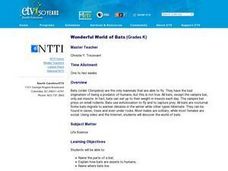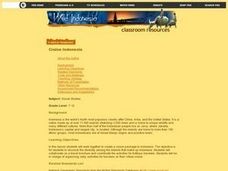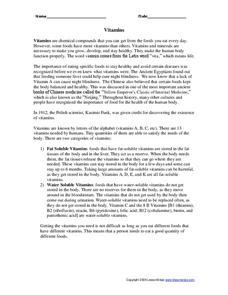Curated OER
Mighty Oaks from Little Acorns
What does it mean to grow? To germinate? For the plan detailed here, class members investigate the growth process of an oak tree while focusing on the beginning stages of planting and germination. They plant seeds and record observations...
Curated OER
No is No, Si is Yes
Third graders match the body part words in Spanish to a picture. They receive a picture of a human with lines coming from its feet, hands, and arms. Students use a word bank, to write the Spanish word that corresponds to the picture. ...
Curated OER
Zoo Vet
Young scholars come up with a list of all the animals that might be found in a zoo. They think of all the things that a zoo needs to do and provide for each animal. They discuss what the role of any zoo should be. They design a healthy...
Curated OER
Wonderful World of Bats
Students create a book about bats. They write a letter to a scientist containing questions about bats. They compare the socialization of bats to humans; compare the needs of bats to humans and other animals.
Curated OER
Carrying Capacity of Ecosystems
Students define population and carrying. In this algebra lesson, students explore exponential growth and decay based on animals and things that grow or decrease exponentially. They graph their findings and discuss their results as they...
Curated OER
Let's Get Warm!
Learners investigate various methods that animals use to warm up in cold weather. They also explore the science principals involved. They then identify a human parallel, discuss what we can learn from nature, and create multimedia...
Curated OER
Down, Dung and Dirty
Students observe the changes seen in succession and the biodiversity of a community through its species richness and evenness. They create a dung culture in a clear plastic cup from horse, goat or cow dung then observe the numbers of...
Curated OER
Community Video and Brochure about Horse Therapy
Students research basic information about horses, horse care and horse therapy effects on humans. They identify what horses need to be healthy and research needed supplies and funds. Students work in groups to prepare an educational...
Curated OER
Stem Cells: 5 Year Progress Report
Students explore different aspects of stem cells. In this human biology lesson plan, students complete numerous activities including reading an article and discussing it, watching a video on stem cells reproducing over time, and...
Curated OER
A Teeth Changing Experience
Students research human health by reading an educational story in class. In this oral health lesson, students identify the importance of brushing their teeth and consuming calcium. Students read the book A Teeth Changing Experience and...
Curated OER
Dirty Decomposers
Students explore the ecosystem by conducting a ziploc bag experiment. In this recycling lesson, students identify decomposer organisms in our environment and how they speed up the recycling process. Students utilize a ziploc plastic bag,...
Curated OER
A Tough Nut to Crack
Sixth graders explore agriculture by examining world geography. In this pecan cultivation lesson plan, 6th graders identify the history of the famous nut and the impact it has on the U.S. economy, diet and human body. Students define...
Curated OER
Renewable Energy Sources
Place learners into groups to research and present different renewable energy sources. As individuals listen to the class presentations, they take notes and then write a persuasive article defending the form of energy that they feel...
Virginia Department of Education
Succession
The final lesson in a two-part series prompts scholars to create newspaper articles and succession events. Applying their knowledge of the ecosystem and the past examples of succession, they predict what will happen in the future using...
The New York Times
Investigating the Heroin and Prescription Opioid Epidemic
How bad is the opioid crisis in America? Has it gotten worse in the last few decades? Why? High schoolers delve into these questions with a thorough and thoughtful lesson from The New York Times on heroin prescription opioids. Starting...
Curated OER
Rock-a-bye Babies in a Wetland
Learners review the way human babies grow and what type of care they need. Using the internet, they are introduced to five different wetland habitat animals and how their babies grow. They discover how they are born and what the...
Curated OER
Building You From Moo
Learners are given an envelope that turns each of them into either a field of grass, or a diary cow, or a famous person (only one type of organism per student). The object is to get the correct building blocks for proteins (amino acids)...
Curated OER
Does Conflict Shape Nations? The Middle East
Students locate settlements and observe patterns in the size and distribution of cities using maps, graphics, and other information. They explain the processes that have caused cities to grow.
Curated OER
Life Science Observations: Living vs. Non Living Things
Students investigate the difference between living and non-living things. In this life science lesson plan, students discover the different characteristics of living things and the natural or human created non-living things. Students...
Curated OER
Cruise Indonesia
Students work together to create a cruise package to Indonesia. They collaborate on a travel brochure and coordinate daily activities for fictitious travelers to discover the diversity among the islands that make up Indonesia.
Curated OER
Vitamins
In this vitamins worksheet, learners read a 2 page article on vitamins, answer 3 statements with multiple choice answers, match 3 types of vitamins with how they help the human body and then answer 4 statements as true or false.
Curated OER
Let's Take a Rock Apart
Students take a crushed rock and sort the remains of the rock minerals into different categories based on the different properties. In this sorting lesson plan, students learn what makes up a rock and how to sort something into categories.
Curated OER
Going Global
Students describe the importance of aquaculture as a source for protein intake by humans globally. They are given a number from 1-3 as they enter the class. All "1's" recieve 10 beans. All "2's" recieve 5 beans. All "3's" recieve 1 bean....
Curated OER
Vertebrate Skeletons
In this biology worksheet, students examine the human skeleton and then classify animal bones according to their similar function.

























